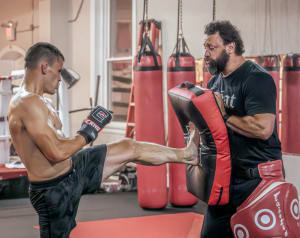
In the ever-evolving landscape of self-defense, martial arts occupy a prominent position, often seen as both a vital tool and a subject of intense debate. As society becomes more aware of personal safety and self-defense, the role of martial arts in this domain has come under scrutiny. Here's a closer look at the controversies surrounding martial arts in today’s self-defense realm.
The Effectiveness Debate
One of the most contentious issues is the effectiveness of martial arts techniques in real-world self-defense situations. Traditional martial arts often emphasize forms, rituals, and a structured approach to combat that may not always translate seamlessly to modern, unpredictable confrontations. Critics argue that some traditional techniques might be outdated or impractical when facing a determined attacker. Conversely, proponents believe that the principles and discipline inherent in martial arts provide a solid foundation for self-defense, regardless of the situation.
We are far removed from the daily attacks of neighboring tribes for land and resources that happened long before today and the birthplace of “martial arts”
This breeds an environment where we’re not being attacked as much, if at all, so people can go as long as decades without ever pressure testing these skills to see if they actually work.
Martial Arts vs. Modern Self-Defense Systems
With the rise of practical self-defense systems like Krav Maga and Brazilian Jiu-Jitsu which are designed specifically for real-world scenarios, traditional martial arts are sometimes viewed as less practical. These modern systems focus on neutralizing threats quickly and efficiently, often incorporating techniques from various martial arts and adapting them to current threats. Traditionalists might argue that these systems lack the depth and cultural significance of established martial arts, while others believe that practical effectiveness should take precedence over tradition.
I believe as long as you’re getting as close to the fight as possible, the old adage “drink the water closest to the source for it is less polluted” comes to mind.
You don’t get an opportunity to say “Hey! Please don’t rob or hurt me today, I’m sore or I haven’t been to MA class cuz I’ve been too busy”. What you’ve done leading up to that point has to be enough, and if you’re not scrutinizing the techniques you’re learning and pressure testing them in a controlled environment to make sure the outcome is more often in your favor then what’s the point of even stepping into a martial art facility.
The Role of Training and Real-World Application
Another point of controversy is the training environment. Many traditional martial arts schools focus heavily on controlled sparring and kata (forms), which may not adequately prepare practitioners for the chaos of a real-life confrontation. Critics argue that the lack of realistic scenario training can leave practitioners ill-equipped for genuine self-defense situations. On the other hand, proponents of traditional arts contend that the principles learned through rigorous practice and mental discipline are crucial for handling stress and aggression in real-world scenarios.
Safety and Injury Concerns
The debate over safety and the potential for injury in martial arts training is also significant. Traditional martial arts often involve high-impact techniques and rigorous physical training, which can lead to injuries. While many schools prioritize safety and proper technique, the risk of injury remains a concern. However, consistent training will inevitably make your body far more durable and sustain more abuse which is exactly what you need in a Self defense scenario.
Some modern self-defense systems place a greater emphasis on minimizing physical harm and stress the importance of avoidance and de-escalation strategies, which can be seen as a more pragmatic approach.
I was describing this mindset with a student the other night, is this worth getting killed over or potentially killing someone over?
Listen carefully, Involuntary manslaughter is still manslaughter. Even if you didn’t mean to unalive them, a simple knockout and head hitting a corner of a bench, and not seeking medical attention immediately or any of the other variables in an attack could pose a threat to their life or yours.
When you use this as a litmus test and line it up to all the potential skirmishes, Dunning-Kruger mindset the average person has and arrogant hostile talking people do, you’ll find out that maybe 1%, if that, of all the things you COULD fight over you actually SHOULD fight over!
Also, I can survive a hip toss onto a mat that’s rated for a 4 foot fall, but can I take one on solid concrete or over a car or bench? Not as easily, and even worse could an untrained person, not necessarily a bad person but someone having a bad day survive it, not without changing your life, civilly or criminally.
Sone things are just not worth it.
Conclusion
The role of martial arts in self-defense remains a complex and often controversial topic. While traditional martial arts offer valuable principles and training, the effectiveness and application of these practices in modern self-defense scenarios continue to spark debate. As new self-defense systems and techniques emerge, it is essential for practitioners and instructors to critically evaluate their approaches, ensuring that they provide both practical skills and respect for the rich traditions of martial arts. Ultimately, the goal remains the same: to equip individuals with the skills and confidence to protect themselves effectively and respectfully in a rapidly changing world.


